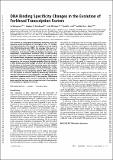| dc.contributor.author | Nakagawa, So | |
| dc.contributor.author | Gisselbrecht, Stephen | |
| dc.contributor.author | Rogers, Julia Maria | |
| dc.contributor.author | Hartl, Daniel L. | |
| dc.contributor.author | Bulyk, Martha Leonia | |
| dc.date.accessioned | 2014-09-16T12:32:45Z | |
| dc.date.issued | 2013 | |
| dc.identifier.citation | Nakagawa, S., S. S. Gisselbrecht, J. M. Rogers, D. L. Hartl, and M. L. Bulyk. 2013. DNA-Binding Specificity Changes in the Evolution of Forkhead Transcription Factors. Proceedings of the National Academy of Sciences 110, no. 30: 12349–12354. | en_US |
| dc.identifier.issn | 1091-6490 | en_US |
| dc.identifier.uri | http://nrs.harvard.edu/urn-3:HUL.InstRepos:12872182 | |
| dc.description.abstract | The evolution of transcriptional regulatory networks entails the expansion and diversification of transcription factor (TF) families. The forkhead family of TFs, defined by a highly conserved winged helix DNA-binding domain (DBD), has diverged into dozens of subfamilies in animals, fungi, and related protists. We have used a combination of maximum-likelihood phylogenetic inference and independent, comprehensive functional assays of DNA-binding capacity to explore the evolution of DNA-binding specificity within the forkhead family. We present converging evidence that similar alternative sequence preferences have arisen repeatedly and independently in the course of forkhead evolution. The vast majority of DNA-binding specificity changes we observed are not explained by alterations in the known DNA-contacting amino acid residues conferring specificity for canonical forkhead binding sites. Intriguingly, we have found forkhead DBDs that retain the ability to bind very specifically to two completely distinct DNA sequence motifs.We propose an alternate specificity-determining mechanism whereby conformational rearrangements of the DBD broaden the spectrum of sequence motifs that a TF can recognize. DNA-binding bispecificity suggests a previously undescribed source of modularity and flexibility in gene regulation and may play an important role in the evolution of transcriptional regulatory networks. | en_US |
| dc.description.sponsorship | Organismic and Evolutionary Biology | en_US |
| dc.language.iso | en_US | en_US |
| dc.publisher | Proceedings of the National Academy of Sciences | en_US |
| dc.relation.isversionof | doi:10.1073/pnas.1310430110 | en_US |
| dc.relation.hasversion | http://www.ncbi.nlm.nih.gov/pmc/articles/PMC3725104/ | en_US |
| dash.license | LAA | |
| dc.subject | transcription factor binding site motif | en_US |
| dc.subject | protein–DNA interactions | en_US |
| dc.title | DNA-Binding Specificity Changes in the Evolution of Forkhead Transcription Factors | en_US |
| dc.type | Journal Article | en_US |
| dc.description.version | Accepted Manuscript | en_US |
| dc.relation.journal | Proceedings of the National Academy of Sciences | en_US |
| dash.depositing.author | Hartl, Daniel L. | |
| dash.waiver | 2013-06-10 | |
| dc.date.available | 2014-09-16T12:32:45Z | |
| dash.affiliation.other | Division of Genetics, Department of Medicine, Harvard Medical School | en_US |
| dash.affiliation.other | Department of Pathology, Harvard Medical School | en_US |
| dc.identifier.doi | 10.1073/pnas.1310430110 | * |
| dash.contributor.affiliated | Gisselbrecht, Stephen | |
| dash.contributor.affiliated | Rogers, Julia | |
| dash.contributor.affiliated | Hartl, Daniel | |
| dash.contributor.affiliated | Bulyk, Martha | |


